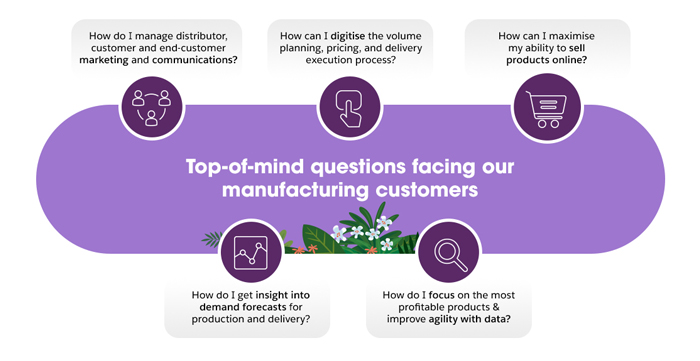For the past two years, manufacturers have focused on mobilising, stabilising, and adapting to the COVID-19 crisis and its related supply chain disruption. Now, with vaccines controlling the spread of the pandemic, it’s time to move forward and focus on growth.
A lot has changed in two years. Industry trends are driving manufacturing companies to become more digital and data-driven. Almost 50% or more of manufacturers surveyed by Salesforce say that the aftermath of COVID-19 has permanently altered just about every aspect of their business – from sales capabilities and customer service, to production and supplier capacity. The majority of salespeople have had to adapt to brand-new ways of selling — with new responsibilities and metrics for success.
Customer expectations have also changed: customers today look for not just a great product, but also personalised service, mass-customisation, and digital-first interactions. All this necessitates a design-driven approach to manufacturing, which starts with sales teams understanding customers better – not just what customers want, but why they want it. Knowing their challenges, in depth, is key to surfacing and satisfying unmet needs.
Even as manufacturers meet these changing expectations, they must compete with new entrants that are unencumbered with legacy systems. This requires manufacturers to be nimbler in how they sell and adapt to customer demands. Yesterday’s playbook with its overly manual approach to selling will no longer suffice. Instead, innovative new approaches and tools will be necessary to achieve sales success in the current landscape.

It’s clear from our conversations with manufacturers that digital is the way forward for sales. Digitising sales and operations planning (S&OP),will help manufacturers boost efficiency, reduce time-to-revenue, and lower costs. In fact, future-ready manufacturers – i.e., those who feel very prepared for the next decade – are 3.5 times more likely to have completely moved their S&OP to the cloud. And 77% of those in the cloud have mostly or entirely automated sales forecasting processes, enabling them to adapt quicker to market changes.
The digital imperative will only grow stronger, opening up new opportunities for manufacturers to power sales growth, and rise above the competition.
5 recommendations for growth
Here’s how your manufacturing company can boost sales revenue and customer delight:

- Estimate the market size and targeted sectors. Can you serve them profitably? Focus on value rather than volume.
- Build a go-to-market strategy across online and offline channels. Identify your channel partners. Will you be offering customers a bundled product or a solution with an associate partner?
- Explore new market segments. Identify emerging trends, disruptions, methods to create value, and innovations.
- Build an influencer ecosystem to positively impact customers’ purchasing decisions.

- Focus on a segment-based value proposition to make your messaging more targeted. This leads to shorter sales cycles, higher margins, and repeat business.
- Remember that your top 20 customer accounts are probably responsible for 80% of your sales. Concentrate on deepening these engagements.
- Assign your top strategic accounts to members of your leadership team. Publish a meeting calendar to encourage leadership-customer interactions. This can be a win-win for both customers and your organisation.

- Remember that growth requires investment. There is always an urgent need to onboard sales talent and build capabilities that are aligned to client needs.
- Recalibrate sales and marketing competency requirements for a digital era. Hire sales teams that are comfortable with data, analytics, problem-solving, and strategic-thinking capabilities.
- Cultivate a workplace culture that’s attractive to a younger generation of workers, and offers the kind of forward-thinking, fast-moving employee experience that millennials expect.
- Ensure that business unit leaders and talent managers execute promptly, so that (1) the planned talent and resources are able to hit the ground running, and (2) business objectives are achieved consistently, quarter after quarter.

- Streamline lead management, including sourcing, qualification, prioritising, and closing. Three factors are important – your visibility of the market, your level of participation in it, and your effectiveness at conversions.
- Optimise lead capture and nurturing using a digital ecosystem with internal sources and external partnerships. Use predictive analytics to prioritise and classify leads. Then, use an action grid to define recommended sales actions and value propositions.
- Develop incentives around sales productivity, risk-return trade-offs, and territory potential for both internal sales teams and channel partners.
- Digitise influencer and channel loyalty programs to connect better with your partners.
- Personalise customer experiences with timely access to customer transaction data.
- Use technology to deal better with uncertainty in forecasting. Having a single source of truth on inventory, orders, and the financial implications of planning for too much or too little will go a long way in helping you mitigate long-term risks.

- Cultivate discipline with a well-defined sales cadence, war room, real-time pipeline dashboards, and periodic win-loss reports. Implement robust analytics to track and review sales performance.
- Track how satisfied customers are with your product quality, service, delivery, customisation, pricing, and contracting. Among your key accounts, monitor the strength of customer relationships. Are your customers brand evangelists, opportunists, or detractors? Remember that happy customers can be your best advocates.
Transform the lead to delivery process with Salesforce
Customers today are looking for a connected experience from a brand that can understand their needs, personalise their experience, and deliver with transparency.
Manufacturing CRM solutions from Salesforce can help you become a sales-winning machine with higher quality leads, better collaboration among teams, and improved sales productivity.
A 360-degree customer view can help you connect with customers in a whole new way, while also cross-selling and upselling with ease. Your sales, production, and planning can all be connected on one platform to keep your business on track. And an intuitive configure-price-quote (CPQ) functionality makes it simple to determine the right solution for customers.
Streamline your entire customer lifecycle with Salesforce:
- Lead management: Target the right messaging to the right customers with marketing automation. Build 1:1 customer journeys to convert interested leads to opportunities. Prioritise and respond to hot leads faster with robust lead scoring mechanisms.
- Opportunity management: Guide opportunities through a digital sales process with seamless collaboration across sales teams.
- Pricing/quote management: Configure and generate quotes with adjusted pricing and discounts. Efficiently manage approvals.
- Deal management: Improve visibility into the technical and commercial terms of each deal. Accelerate deal finalisation and e-signatures through automation.
- Service management: Provide omni-channel support for customer queries, ranging from technical questions to delivery and claims support.
- Order management: Optimise order processing, inventory management, and fulfillment.
- Invoicing / billing: Efficiently generate invoices from orders. View all payment information in a centralised repository.
- Delivery: Optimise routes and schedule dispatches. Improve delivery tracking. Empower field agents to drive sales.
When our customer 360 approach and manufacturing solutions come together, customers benefit at multiple levels:

 The greatest need at this stage is for manufacturers to streamline B2B interactions – be it supplier-manufacturer, manufacturer-distributor, manufacturer-customer, or distributor-customer interactions. This will help ensure that the end customer has a seamless experience from start to finish while ordering a particular product or customising a service.
The greatest need at this stage is for manufacturers to streamline B2B interactions – be it supplier-manufacturer, manufacturer-distributor, manufacturer-customer, or distributor-customer interactions. This will help ensure that the end customer has a seamless experience from start to finish while ordering a particular product or customising a service.

























